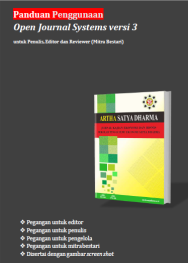The Effect Of Work Division And Employee Ability On Employee Performance At Hotel Puri Lumbung Munduk Village
Abstract
The purpose of this study was to determine the Division of Work affect the Performance of Employees at the Hotel Puri Lumbung Munduk Village and determine the ability of Employees to affect the Performance of Employees at the Hotel Puri Lumbung Munduk Village. Data collection techniques used in this study were questionnaires. The sampling technique used in this study is Probability sampling. The respondents used were 68 people. The data analysis technique used in this study is simple multiple regression analysis using SPSS 21 for windows.The results obtained based on the results of the study in multiple regression analysis obtained the results of the study the effect of the Division of Work (X1) on Employee Performance (Y) significant positive effect on Puri Lumbung Hotel, Munduk Village. From the results of the multiple linear regression equation it can be seen that the regression coefficient of the Work Distribution variable is 0.246 and is positive which means that if there is an increase in Work Distribution by one, it will cause an increase in Employee Performance by 0.246 assuming other variables in this equation are constant. Based on the results of the T test can be seen the value of the regression coefficient of the Division of Labor is equal to 0,000 with a significance of 0.05 and is supported by the calculation of the tcount of 4.023> from the table 1.669. While the results of the study the effect of Employee Ability (X2) on Employee Performance (Y) significantly positive effect on Puri Lumbung Hotel, Munduk Village. From the results of the multiple linear regression equation, it can be seen that the regression coefficient of the Employee Ability variable is 0.726 and is positive which means that if there is an increase in Employee Ability by one, it will cause an increase in Employee Performance by 0.726 assuming other variables in this equation are constant. Based on the results of the partial test T test data, showed that the regression coefficient of the Employee Ability variable (X2) was 0,000 with a significance of 0.05 and was supported by the calculation of the tcount of 5.195> from the table 1.669.
Downloads
References
Atika, Andria, Milka. 2020. “Pengaruh Perputaraan Persediaan Perputaraan Piutang dan Perputaraan Kas Terhadap Profitabilitas Pada Perusahaan Sektor Industri Barang Konsumsi Yang Listing Di Bursa Efek Indonesia”. Jurnal Ilmu Manajemen dan Akuntansi, Vol. 8. No. 2, hal 13-15.
Ghozali, I. 2016. Aplikasi Analisis Multivariate dengan Program SPSS. Edisi 7. Badan Penerbit Universitas Diponegoro, Semarang.
Harahap, Sofyan. “Analisis Kritis atas Laporan Keuangan”, Cetakan kesebelas, PT. Raja Grafindo Persada : Jakarta, 2013.
Husnan, Suad dan Enny Pudjiastuti. 2004. Dasar-dasar Manajemen Keuangan. Edisi Keempat. Yogyakarta: UPP AMP YKPN
Kasmir, “Pengantar Manajemen Keuangan”, Cetakan Kedua, Kencana Prenada Media Group : Jakarta, 2010.
Munawir, ”Analisis Laporan Keuangan”, Liberty : Yogyakarta, 2010.
Nuriyani, N., & Zannati, R. (2017). Pengaruh Perputaran Kas dan Perputaran Piutang Terhadap Profitabilitas Perusahaan Sub-Sektor Food and Beverages Tahun 2012-2016. Jurnal Riset Manajemen dan Bisnis (JRMB) Fakultas Ekonomi UNIAT, 2(3), 425-432.
Nurmawardi, F., & Lubis, I. (2019). Pengaruh Perputaran Kas dan Perputaran Piutang terhadap Profitabilitas PT. Indofood Sukses Makmur TBK. Jurnal Madani: Ilmu Pengetahuan, Teknologi, dan Humaniora, 2(1), 103-112.
viRahma, Aulia. 2011. “Analisi Pengaruh Manajemen Modal Kerja Terhadap Profitabilitas Perusahaan”. Jurnal Ekonomi.
Rika Ayu Nurafika. 2018. “Pengaruh Perpuataran Kas Perpuatran Piutang, Perputaraan Persediaan Terhadap Profitabilitas pada Perushaan Semen”. Jurnal Akuntansi dan Bisnis, Vol.4. No. 1, hal. 11-20.
Ririn, Rusnaeni. 2017. “Pengaruh Perputaraan Piutang, Perputaran Kas, dan Perputaraan Persediaan Terhadap Profitabilitas PT Ultrajaya Milk Industry & Trading Company, TBK.’’ Jurnal Akuntansi Ekonomi, Vol. 7. No. 1, hal. 34-60.
Riyanto, Bambang. “Dasar-Dasar Pembelanjaan Perusahaan”, Edisi Empat, BPFE : Yogyakarta, 2011.
Rudianto. (2010). Akuntansi Koperasi Edisi Kedua.Jakarta.Erlangga. SAK (Standar Akuntansi Keuangan) tentang pengertian laporan keuangan
Santoso, Rahmat Agus dan Mohammad Nur. 2008. “Pengaruh Perputaran Piutang dan Pengumpulan Piutang Terhadap Likuiditas Perusahaan Pada CV. Bumi Sarana Jaya Di Gresik”. Jurnal Logos, Vol. 6, No. 1, hal. 37 – 54.
Sartono, Agus. “Manajemen Keuangan Teori dan Aplikasi”, (4th ed), Yogyakarta: BPFE, 2010. Sodikin dan Riyono. 2014. Akuntansi Pengantar I. Yogyakarta: Sekolah Tinggi Ilmu Manajemen YKPN.
Sawir, A. (2018). Analisis Kinerja Keuangan dan Perencanaan Keuangan. Jakarta: Gramedia Pustaka Utama.
Sudana, I. M. (2011). Manajemen Keuangan Perusahaan. Jakarta: Erlangga. Sugiyono. (2014). Statistika Untuk Penelitian. Cetakan ke 21. Bandung :Alfabeta Sutrisno,”Manajemen Keuangan”, Ekonisia, Kampus Ekonomi UI : Yogyakarta,2013. Undang- undang RI No. 25 Tahun 1992.Tentang Perkoperasian.
Sufiana, N., & Purnawati, N. K. (2013). Pengaruh Perputaran Kas, Perputaran Piutang dan Perputaran Persediaan terhadap Profitabilitas. E-Jurnal Manajemen, 2(4), 451-468.
Utami, M. T. (2018) Analisis Pengaruh Perputaran Kas, Perputaran Piutang, dan Perputaran Persediaan terhadap Profitabilitas.
Nuryani, N. N. J. (2021). Triggers For Stock Prices In Manufacturing Companies In The Food and Beverages Sector On The Indonesia Stock Exchange. International Journal of Social Science and Business, 5(4), 468-474.
Made, D. H. I., Gde, B. I., Made, S. U., & Wayan, M. Y. I. G. (2019). Cultural management of economic resistance in Bali Aga community village of Kecamatan banjar district Buleleng. Russian Journal of Agricultural and Socio-Economic Sciences, 93(9), 183-192.
Ningsih, L. K., Prastiwi, N. L. P. E. Y., & Ayuni, N. M. S. (2019). The Implementation of Organizational Culture Based on Tri Hita Karana in the Effort to Realize the Organizational Performance in PDAM Buleleng Regency. International Journal of Social Science and Business, 3(2), 77-85.
Ningsih, L. K., & Prastiwi, N. L. P. E. Y. (2019). Improving the Quality of Human Resources in Indigenous Village Institutions Through Work Culture Based on" Catur Marga" in Bali Aga Village, Buleleng Regency. International Journal of Social Science and Business, 3(3), 306-313.
Prastiwi, N. L. P. E. Y., Ningsih, L. K., & Rianita, N. M. (2018). The Application of Strategic Human Resource Practice Based on Tri Kaya Parisudha to Improve The Performance of Village Financial Institution Employees in Buleleng Regency. International Journal of Social Science and Business, 2(4), 245-250.
Budiasni, N. W. N., Ayuni, N. M. S., & Trisnadewi, N. K. A. (2019). The Implementation of Spiritual Capital Saab Mote Craftsmen: Study of The Hindu Teachings (Study of Saab Mote Craftsman in Nagasepaha Village, Buleleng). International Journal of Social Science and Business, 3(3), 336-340.
Ayuni, N. M. S., Gorda, A. A. N. E. S., & Budiasni, N. W. N. (2019). ORIENTASI KEWIRAUSAHAAN SAAB MOTE DESA NAGASEPAHA SEBAGAI PRODUK IKONIK. Jurnal Ilmiah Manajemen dan Bisnis, 4(1), 1-11.
Ayuni, N. M. S., & Budiasni, N. W. N. (2019). The Strategy of Bad Loans “Pang Pade Payu” in Village Credit Institution in Buleleng District. International Journal of Social Science and Business, 3(4), 542-548.
Budiasni, N. W. N., Ayuni, N. M. S., & Trisnadewi, N. K. A. (2020). Evaluasi Kinerja Keuangan pada Pengembangan Jaringan 4G PT. Telekomunikasi Indonesia di Singaraja. Jurnal Akuntansi Profesi, 11(1), 107-114.
Ayuni, N. M. S., & Budiasni, N. W. N. (2020). The Implementation of Profit Sharing at Lembaga Perkreditan Desa. International Journal of Social Science and Business, 4(3), 472-479.
Ayuni, N. M. S., & Budiasni, N. W. N. (2020). The Implementation of Profit Sharing at Lembaga Perkreditan Desa. International Journal of Social Science and Business, 4(3), 472-479.
Budiasni, N. W. N., & Ayuni, N. M. S. (2020). Transparency and Accountability Based on The Concept of “Pada Gelahang” Enhancing Village Financial Management. International Journal of Social Science and Business, 4(3), 501-508.


